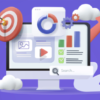Free
AI Business Trend Report
Get insights from tech leaders on the impact of AI in the workplace. Discover surprising findings from our 2023 AI in Business Trend Report.
“I thought people would be more afraid of AI taking over their jobs.”
“I was shocked to learn that VPs and directors feel the most threatened by generative AI tools.”
“There’s a huge market opportunity for AI consultants who can help organizations use AI ethically and effectively.”
We conducted a survey of 500 tech professionals to understand their thoughts on generative AI in the workplace. We then reached out to three experienced tech leaders who use AI tools to get their perspectives on our findings. The quotes above are just a taste of the insightful responses they provided.
Keep reading to meet these talented tech leaders and hear more about how AI is shaping the way we work.
Don’t forget to download our report and join the conversation on our official LinkedIn page!
Let’s hear from the tech leaders:
– Kelly O’Halloran:
Senior Manager of Content Strategy at QuotaPath. She leads content marketing efforts to attract and engage customers throughout the sales and customer funnel.
– Shelby Bolinger:
Director of Marketing Programs at Built In. She drives brand awareness and engagement with key buyer personas through marketing campaigns and programs.
– Jerlyn O’Donnell:
Director of Experience Design at FCB Health. She oversees a team of product design and user experience experts, bringing digital products to life.
Now, let’s dig deeper into their experiences with generative AI tools.
Kelly O’Halloran relies on Bard multiple times every day, while Shelby Bolinger is still learning about AI tools and how they fit into daily workflows. Jerlyn O’Donnell has been using generative AI tools frequently since August 2022, finding them valuable for various tasks.
What surprised our tech leaders the most about the report?
Kelly O’Halloran was surprised by the low adoption rates of AI tools in both small and large companies. She also found it interesting that concerns about quality ranked second as an obstacle for non-users, surpassing budget limitations.
Shelby Bolinger was taken aback by the high adoption rate of AI tools across job functions and the speed at which they have become widely used.
Jerlyn O’Donnell was shocked to learn that VPs and directors feel threatened by generative AI tools, as she expected them to be more receptive to innovation.
What surprised you the least at the recent survey results?
O’Halloran:
I found it interesting but not surprising that companies with 201-500 employees had the highest adoption of AI. This makes sense because these companies are in a good position for growth and are always looking for ways to be more efficient. It also wasn’t surprising that c-suite executives were the most confident that technology couldn’t replace them.
Bolinger:
I wasn’t surprised to learn that professionals at smaller companies were adopting AI at a higher rate. These companies are resourceful and always find ways to make the most of what they have. AI is a perfect fit for them because it helps them get more work done quickly.
O’Donnell:
It’s not surprising that the cost of generative AI tools is a barrier to adoption. As someone who personally pays for these tools, I know they can be expensive. But I believe the investment is worth it. However, I understand that not everyone can afford to invest in these tools independently. That’s why I hope companies will start investing in them for their employees, even if they don’t work in departments that would immediately benefit from them.
It’s disheartening to see so many companies miss out on the benefits of generative AI due to short-term thinking. They could be more productive and profitable if they embraced these tools. This short-sightedness will only hurt them in the long run as they fall behind competitors.
What interested you the most in the survey?
O’Halloran:
I was intrigued by the fact that creativity was ranked highest as the skill needed to use generative AI efficiently. It challenges the notion that AI is anti-creative and shows that creatives can actually excel with the help of these tools.
I also found it interesting that while 68.4% disagreed with the idea that AI would take their jobs, there is still a significant portion who are concerned. However, I haven’t seen evidence of AI replacing jobs. People are being laid off for other reasons. AI tools like this one can enhance productivity, not replace workers.
Bolinger:
Yes, it was interesting that nearly 70% of respondents weren’t worried about AI taking over their jobs. Considering recent job cuts in the technology industry, I expected more fear about AI replacing human roles.
O’Donnell:
I was surprised that freelancers and solopreneurs weren’t leading the adoption of generative AI tools. I thought they would be the first to embrace this technology. However, it makes sense that they may have less exposure to these tools and a steeper learning curve compared to individuals at larger companies who can learn from each other.
What do you think will change the most in the next year based on these insights?
O’Halloran:
I believe there will be a huge market opportunity for AI consultants who can help organizations properly and ethically implement AI and understand how to control it. Just like revenue operations emerged as a new role in tech, I foresee the rise of AI implementation consultants as adoption increases. The eagerness is there, now companies just need guidance on how to use AI effectively.
Bolinger:
I think the biggest change will be in budget allocation for AI tools. As adoption and trust in these tools increase, organizations will realize the ROI they can achieve with this investment.
O’Donnell:
More people will adopt generative AI tools if they aren’t heavily regulated. Companies are competitive and won’t hold out if their rivals fully embrace the technology. I expect to see growth in generative AI usage across demographics in the workplace as time goes on. Those who resist using these tools are ultimately holding themselves back and will need to catch up in the evolving workplace.

How will human workers adapt as generative AI becomes more prevalent in the workplace?
Bolinger: It’s an evolution. I believe some companies will heavily invest in AI, potentially neglecting their human workforce. However, I anticipate a shift in the opposite direction as we find the perfect balance between humans and AI, creating a highly effective workplace.
O’Donnell:
This question is loaded, but luckily I asked ChatGPT for its take when I first used it. The AI suggested that AI tools will handle repetitive and time-consuming tasks, while humans will tackle more complex and creative work. I completely agree. We should focus on skills that complement AI tools, such as problem-solving, critical thinking, and creativity. This integration of tools into our daily workflow is already happening, although we may not realize it with our current tools.
What do you find most exciting about the future of generative AI?
O’Halloran:
Recently, one of my coworkers used AI to assist with her social media posts. We collaborated and created some heartfelt posts based on her recent panel experience.
These unique applications of AI are incredibly powerful as they help individuals become better versions of themselves. The greatest benefit lies in these tools empowering people to improve skills they previously lacked. With practice, they may even outgrow the need for AI assistance. Additionally, think about non-English speakers who struggle to create a strong cover letter when applying for jobs. Now, they have access to tools that can easily help them craft a basic cover letter, increasing their chances of securing an interview.
O’Donnell:
The potential for AI to revolutionize industries is immense. However, its impact on healthcare is particularly significant, as it affects everyone. Imagine being able to identify potential health risks and receive personalized treatment plans.
If you want to dive deeper into the subject, feel free to download The AI in Business Trend Report for more insights.






























